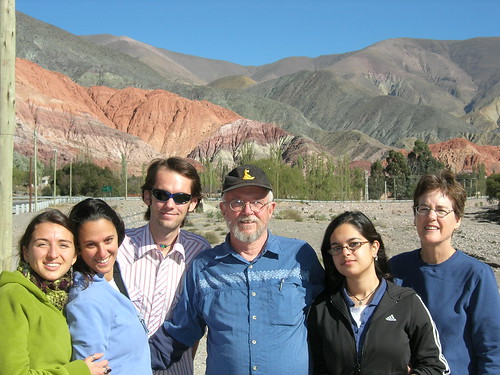
"Quebrada" is the Quechua word for canyon and on Saturday I traveled with four other Cabrillo Spanish students and our tour manager Lucila into this World Heritage site in northwest Argentina. Here the group poses against a backdrop of multi-colored mountains (L-R: Lucila, Susanna, Ryan, me, Smita and Marilyn).
The trip included visits to a number of small villages and historical sights in this area of the country which is surrounded on three sides by Chile, Bolivia and Paraguay. The Bolivian border was not far north of us, and on the other side of the dry mountain range to the west was jungle. I wanted to see Argentina outside of the crowded metropolus, Buenos Aires, and this journey to Salta and points north than rewarded me with a feast of new sights, sounds and smells. In the foothills of the Andes (which, unfortunately, could not be seen), the land here is high in altitude and dry. The weather was sunny and warmer than in the capital, although it was quite cold when the sun went down.
We flew from the riverside airport in Bs As on Friday afternoon and checked into our rooms at the Refugio del Inca Hotel close to the plaza in Salta, a city founded in the 16th century that retains somewhat of a colonial character. Some of it I suspect has been reconstructed for tourist consumption. Salta is a popular vacation destination, for Argentines as well as foreigners. Crops grown in the Lerma Valley were sent to the mountain of silver in Potosi, Bolivia, to feed the thousands of mine workers.
On our first evening we walked to a nearby peña for dinner and a folklorico show. I had cazuela de cabrito, a casserole of stewed goat meat that was quite delicious. The audience was packed with customers and we sat cheek by jowl with a wild group of men from Chaco who whooped and hollared at the dancers, singers, and a ventriloquist whose jokes in Spanish were mystifying to me but whose style of comedy with a dummy was immediately recognizable. The music featured a drum beat and guitars, and a style of singing that included ear-splitting falsetto sounds. Some of the songs were coplas which, I was told, included nonsense rhymes and were common during carnival.
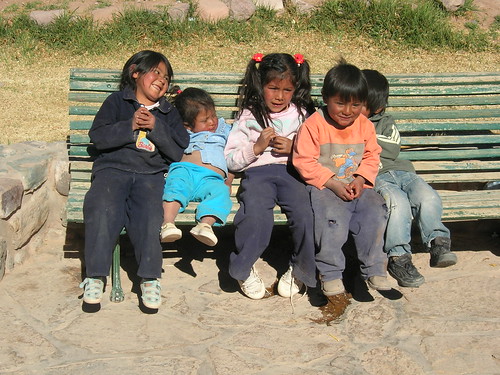
We spent 13 hours on Saturday in a small van, from before sunrise to after sunset, traveling through the painted scenery of the Quebrada de Humahuaca. Most of the inhabitants, like the children pictured above, are closely related to the Quechua people in Peru and Bolivia. They raise goats and llamas and scratch out a living from the dry soil. Diego, our lively guide, told us that the truly poor lived high in the surrounding mountains and were rarely seen. Driving out of Salta, we saw fields of sugar cane, about to be harvested, and were told tobacco was also an important crop (cigarettes are absurdly cheap in Argentina). In addition we saw natural gas pumping stations and electric plants operated by thermal heat. As we entered the canyon we began to see stovepipe cactus every where and in the absence of trees the pockmarked wood was ubiquitous in houses and churches.
The first small village was Purmamarca below the seven colors of the Cerro de los Siete Colores (seen behind us in the first photo). There was a small square full of items to buy (mostly made in factories, we learned) in front of the small Igelsia Santa Rosa de Lima, a 17th century church. Our next stop was El Pucará, an ancient fort atop a hill above the Rio Grande valley, with incredible views north and south, which was discovered in the early 20th century and was believed to have been occupied in pre-Inca times. The houses, however, are reconstructions, and only the scattered rocks on the hillside among the cactus remain from ancient times. Our next stop was Tilcara, the village down the hill which takes its name from that of the pre-Inca civilization. In addition to the square where natives and hippy trekkers sold their art and machine fabrications, there was a museum containing some artifacts from Pucará, including torturous devices for the head which enable the original inhabitants to devlop flat foreheads. This was common in Mexico as well, though I'm not sure why it was appealing. It seems similar to the binding of women's feet in China to achieve some bizarre standard of beauty. But then are things any different today, with piercings and tattoos? In Tilcara I bought a grey sweater that makes me look like an llama, for only about $8. I also found a pirated CD by León Gieko whose song, "La Memoria," was played in class last week by Eugenia. He mentioned some of the Catholic martyrs in the Dirty War like Angelelli and the "padres palotino" who I discovered were three Irish priests killed by the military in Belgrano in 1977.
Our final stop at the north end of the Quebrada was the village of Humahuaca. There we walked through the cobblestone streets to the small plaza in front of the Iglesia de la Candelaria with its image of the town's patron saint and art by the Cuzco painter Marcos Sapaca. I had a bowl of locro, a soup of corn, beans and meat, at La Fontin and we listened to a trio play familiar songs which I always associated with Peru. From the Lonely Planet, I was expecting to be able to order llama stew, but the waitress looked horrified when I asked for it.
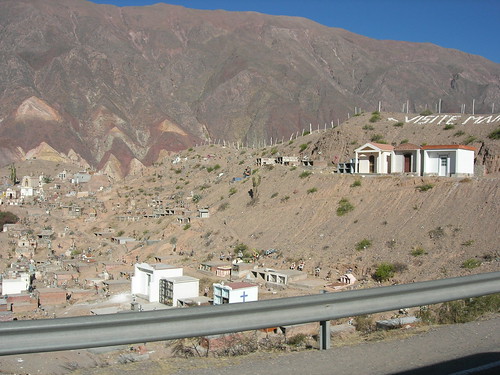
On the way back we stopped on the road to look at Maimará, a small village set against the backdrop of a mountain know as La Paleta de Pintor (the Painter´s Palette), with an amazing hill of tombs, not unlike those at Recoleta. Many of them seemed empty. Do the dead rise here, or are they awaiting fatalities on the highway nearby? There we met a group of people with homemade trinkets which, Diego told us, they did not want to sell. Rather, they wanted us to send them something useful from our home cities. I took one of the objects from a woman named Rosa.
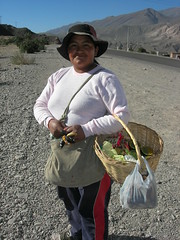 I took her photo and promised to send her a copy when I got back to Santa Cruz. This seemed to me a unique twist to begging (and we were asked for money in every village we visited) which encouraged dialogue rather than charity. Though I rather doubt that Rosa has access to the internet.
I took her photo and promised to send her a copy when I got back to Santa Cruz. This seemed to me a unique twist to begging (and we were asked for money in every village we visited) which encouraged dialogue rather than charity. Though I rather doubt that Rosa has access to the internet.Our last stop before heading to Jujuy at the south end of the Quebrada was the tiny village of Uquia where I photographed the children above. Besides the tiny square with a handful of goods to sell, including small cactus plants that I did not think would travel well in my suitcase, was the Iglesia de San Francisco de Paula which featured paintings of angels armed with Spanish weapons. The artist was also from the Cuzco school which generated much of the church art in colonial South America.
The last stop of the day was in Jujuy (prounced who-whoey), and I took a quick walk around the plaza, into the 18th century Catedral and down a few blocks to the Iglesia San Francisco. This large city, after the day's journey, had little to offer this jaded tourist, and I was ready for the ride back to our refuge in Salta.
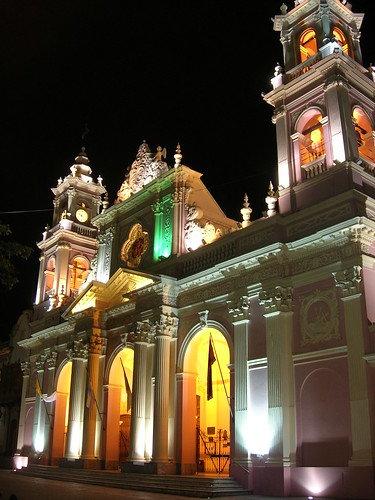
Back in Salta, we separated for dinner, and Marilyn and I walked down to the brightly lit Plaza 9 de Julia where I photographed the colorful Catedral. All of the colonial buildings of the plaza were illuminated and reflections of the 19th century Catedral could be scene in the glass facade of the tall modern building next door. In the center of the plaza was a large statue entirely wrapped in a green tarp. We were told it was under repair from damage caused by excessive pigeon shit. Got to keep up appearances for the tourists. The next day a different guide took us on a tour of Salta and we visited the baroque Iglesia San Francisco where we had seen a mass baptism of infants the night before. The statue of St. Francis in front was, we were told, a present from Italian dictator Mussolini. Then we drove up the Cerro San Bernardo, named for the city´s patron saint, for some incredible views of the city and countryside. Along the way we passed Sunday joggers, walkers and hikers. Our ride down the hill was high above the ground on a telférico; while some of my comrades were a bit nervousat the prospect, I saw that it was constructed by the Swiss and was assured. And I'd taken a similar trip last weekend in Santiago where the teleférico was older and smaller. Our guide took us outside the city to San Lorenzo, an upscale area that grew up around a strange castle built by a visitor for his girlfriend. Beyond the castle is a park around a dry riverbed where people were hiking and riding horses. I bought some flat bread from a woman toasting it over a fire, she had a big hat like a Bolivian. Before heading to the airport, we visited the Mercado Artisanales where crafts not made by machine were sold. On the lawn in front two dogs were stuck in an amorous embrace. Inside I finally found a poncho that I liked, but when I looked at the price tag, I gagged. 500 pesos, or about $160. I went across the street and found a satisfactory poncho for 40 pesos.
All in all, my expedition to the northwest was an enjoyable weekend and a welcome alternative to the hustle and bustle of Bs As. While I can't get away to Patagonia and Tierra del Fuego, at least on this trip, I did get a sense of what Argentina is like outside of the commanding capitol. We learned a little of Cordoba, a large city near the wine growing area of Mendoza, from an architect who joined our tour of the Quebrada with his family. He said that there was so much construction going on that he had to turn down jobs. So obviously there are parts of Argentina that are prosperous and recovering from the disastrous economic meltdown of ten years ago.
Now, on this rainy Monday, I have to do mucho homework that I've neglected since last Wednesday. It's the last week of school and I have to give a report on the barrio of La Boca on Wednesday and take a final exam on Thursday. Some in our group are going tomorrow to Colonia in Uruguay but I feel I need to devote this last week to one of my goals of improving my Spanish. The other goal -- seeing Argentina and Santiago -- has been fulfilled beautifully.



No comments:
Post a Comment